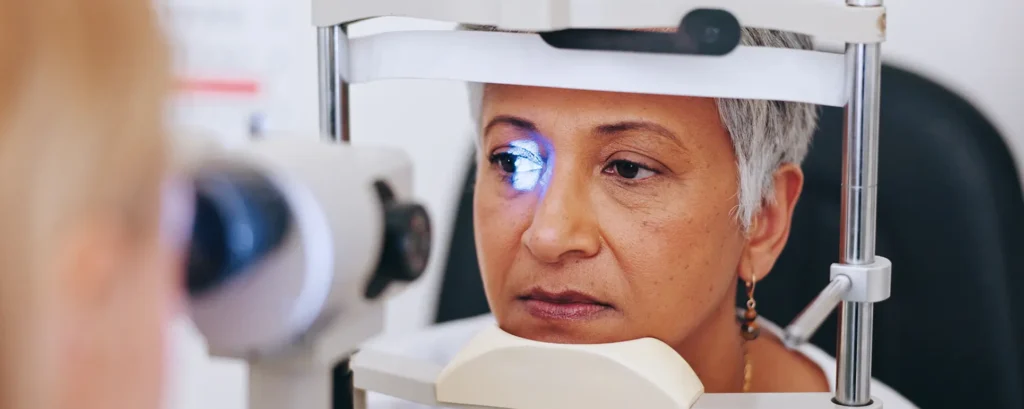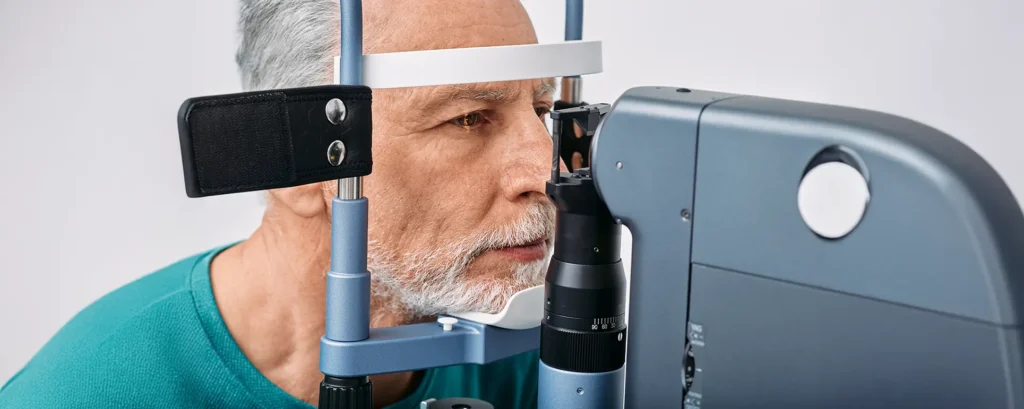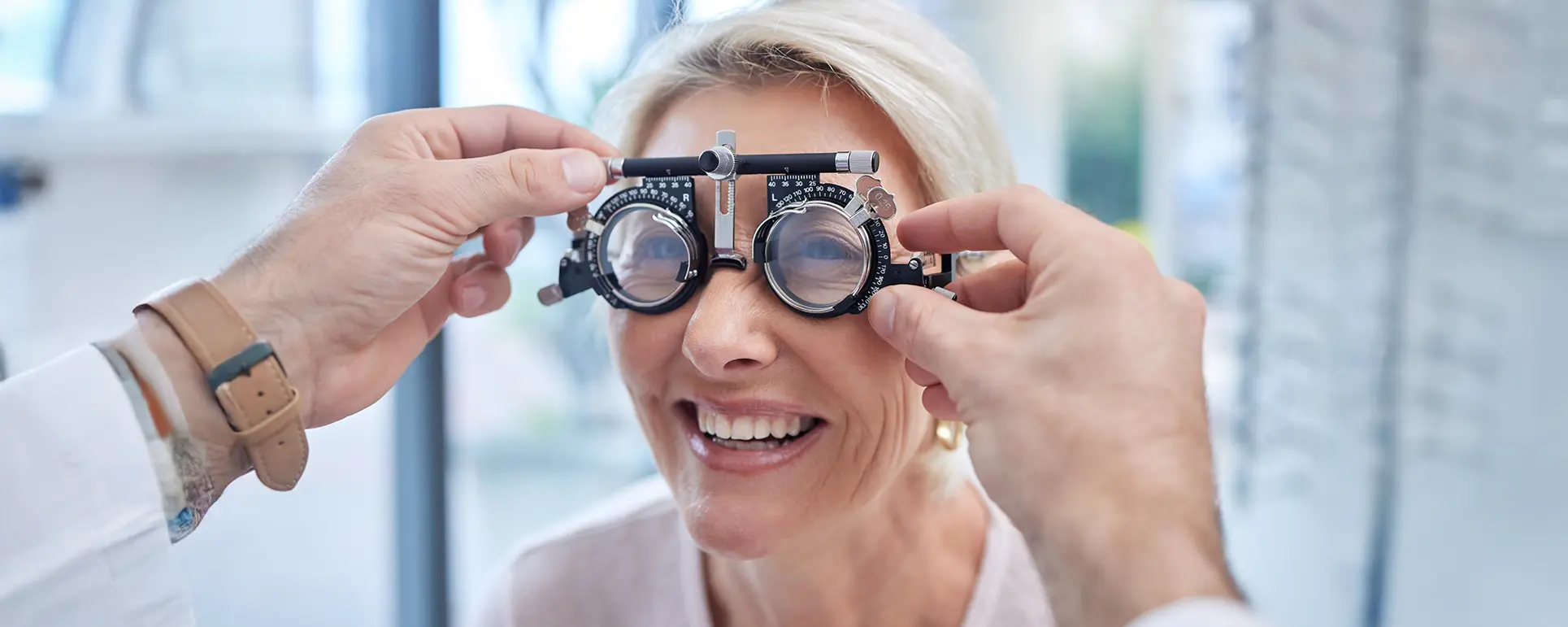If you’ve had cataract surgery or refractive lens exchange and feel your vision still isn’t quite where you want it to be, you’re not alone. Sometimes, even with careful calculations, your final prescription may settle slightly off target, leaving you with small refractive errors like mild short-sightedness, long-sightedness, astigmatism or unexpected blur. You might be wondering whether you need to replace your existing lens or whether there’s a less invasive solution to fine-tune your vision.
This is where piggyback lenses, also known as secondary intraocular lenses (secondary IOLs), come in. Rather than removing your original implant, a second lens is placed in the eye to refine your focus. In this guide, I want to help you understand when piggyback lenses are used, how safe they are, what the benefits are compared with an IOL exchange, and who might be an ideal candidate for this procedure.
What Are Piggyback Lenses?
A piggyback lens is an additional intraocular lens inserted into the eye after the primary IOL has already been placed during cataract or refractive lens surgery.
Key characteristics:
- They sit in front of or behind the existing IOL
- They correct refractive “surprises” or residual prescription
- They avoid removing the primary IOL
- They are typically thin, customised and highly precise
Piggyback lenses are often used when achieving perfect vision after surgery requires small, precise adjustments rather than a full lens exchange.
Why Might You Need a Piggyback Lens?

Even with the best equipment and calculations, the final power of an IOL can occasionally settle slightly differently than predicted. This is because every eye heals uniquely.
Common reasons for needing a secondary IOL:
- Mild refractive error after cataract surgery
- Unexpected astigmatism
- Vision not sharp enough at a distance
- Near tasks still blurry
- Intolerance to glasses after surgery
- Desire for greater spectacle independence
- Avoiding the risks of removing the first lens
Piggyback lenses provide precise correction without disturbing the primary lens.
How Piggyback Lenses Work
During the procedure, a surgeon:
- Evaluates your current prescription
- Calculates the exact power needed
- Places a thin customised IOL in front of or behind your existing implant
The two lenses work together to fine-tune the focus of your eye much like wearing very thin extra optical assistance inside the eye.
Are Piggyback Lenses Safe?

Yes, piggyback lenses are considered safe when implanted by an experienced surgeon and when the right type of lens is chosen.
They are generally safer than an IOL exchange because:
- The original lens remains undisturbed
- There is no need to enter the capsular bag again
- There is less risk of capsular rupture
- There is significantly lower risk of zonule damage
- The procedure is shorter and less invasive
- Healing is typically faster
Piggyback lenses have been used for decades, and modern materials and designs have made them more stable and biocompatible.
Where Is the Piggyback Lens Placed?
There are two main positions for secondary IOLs.
1. Sulcus-Fixated Piggyback Lens
This is the most common location.
The lens sits in the ciliary sulcus, which is in front of the primary lens but behind the iris.
Benefits:
- Avoids disturbing the primary IOL
- Ideal for refractive touch-ups
- Suitable for many eyes anatomies
- Good stability
Considerations:
- Proper sizing and lens design are important
- Surgeon expertise is essential
2. Capsular Bag Placement (Less Common)
If the original capsule is open or specific conditions are present, the secondary lens may be placed in the capsular bag alongside the original lens.
Benefits:
- Excellent stability
- Reduced risk of movement
Limitations:
- Not suitable for everyone
- Capsule must be wide enough and intact
Piggyback vs IOL Exchange: Which Is Better?
If you need your vision fine-tuned, your two options are:
- Piggyback lens (secondary IOL)
- IOL exchange (removing and replacing the original lens)
Here’s how they compare.
Piggyback Lenses:
Pros
- Less invasive
- Lower risk of complications
- Faster healing
- No disruption to the capsular bag
- Excellent for small refractive refinements
- Easier for patients with fragile anatomical structures
- Reversible if needed (much easier than removing original IOL)
Cons
- Requires precise measurement
- Needs surgeon experience
- Must use specific lens types
IOL Exchange:
Pros
- Entire lens power can be changed
- Suitable for significant errors
Cons
- Higher risk of capsular rupture
- More invasive
- Longer recovery
- Greater risk of tissue damage
- Limited by capsular fibrosis
Conclusion:
Piggyback lenses are safer in most cases, especially when only a small correction is needed.
Benefits of Piggyback Lenses
Piggyback lenses aren’t just safe they offer multiple advantages that many people don’t realise.
1. Perfect for Small Refractive Errors
If you only need a small adjustment (e.g., -0.75D or +1.00D), piggyback lenses achieve this without replacing the primary lens.
2. Reversible if Necessary
If you do not adapt well, the piggyback lens can be removed or replaced far more easily than the primary IOL.
3. Great for Complex Eyes
Eyes with unusual anatomy often benefit from piggyback lenses because they avoid disturbance to delicate structures.
4. Useful for Multifocal or Premium IOL Adjustments
If you already have a premium IOL and your vision isn’t balanced, piggyback lenses are an excellent solution.
5. Can Correct Astigmatism
Toric piggyback lenses allow additional astigmatism correction without touching the original lens.
What About Side Effects?
As with any procedure, piggyback lenses have some risks, though they are generally low.
Potential side effects include:
- Mild inflammation
- Temporary light sensitivity
- Glare or halos (usually temporary)
- Mechanical interaction with the primary lens (rare)
- Pigment dispersion (if sizing is incorrect)
- Pressure changes (rare and typically manageable)
Choosing the right lens design reduces most of these risks.
Who Is a Good Candidate for a Piggyback Lens?
You may be an ideal candidate if:
- You have a small to moderate refractive error after lens surgery
- Your eye anatomy supports sulcus placement
- You want to avoid the risks of IOL exchange
- You have a stable prescription post-surgery
- You want greater spectacle independence
- You feel that glasses don’t fully correct your vision
Your surgeon will take detailed measurements to confirm suitability.
Who Should Avoid Piggyback Lenses?
Piggyback lenses may not be ideal if:
- You have severe dry eye
- You have uncontrolled glaucoma
- You have recurrent uveitis
- You have significant capsular fibrosis
- You require a large refractive change
Your surgeon will discuss alternatives if needed.
How Surgeons Choose the Right Piggyback Lens
The success of a piggyback lens depends heavily on the right calculations.
Surgeons will assess:
- Axial length of the eye
- Corneal curvature
- Current IOL power
- Exact refractive error
- Sulcus size
- Angle anatomy
- Stability of primary IOL
Modern biometry technologies make these calculations highly accurate.
Piggyback Lens Procedure: What to Expect
The procedure is usually straightforward.
Steps include:
- Local anaesthesia
- Micro-incision at the corneal edge
- Inserting the secondary IOL
- Positioning it safely in the sulcus
- Closing the incision (often self-sealing)
Most patients go home the same day.
Recovery After Piggyback Lens Implantation
Typical recovery timeline:
- Day 1: Mild discomfort
- Week 1: Increasing clarity
- Weeks 2–4: Vision stabilises
- Months 1–3: Final results
Most people return to normal activities within a few days.
Long-Term Results
Piggyback lenses offer excellent stability and long-term clarity.
You can expect:
- Sharper focus
- Reduced dependence on glasses
- Stable results for many years
- Strong compatibility with the original IOL
Most patients describe the improvement as life-changing.
Piggyback Lenses for Astigmatism
Toric piggyback lenses are designed specifically for astigmatism.
They provide:
- Precise rotational stability
- Excellent refractive accuracy
- Smooth blending with the original IOL
This is often a better option than exchanging the original IOL.
Piggyback Lenses for Multifocal IOL Corrections
If you received a multifocal IOL and experience imbalance between eyes or uneven clarity, piggyback lenses can help by:
- Adding distance or near strength
- Improving contrast
- Reducing visual strain
This is especially useful when the primary lens is otherwise functioning well.
Piggyback Lenses vs Laser Vision Correction (LASIK/PRK)
In some cases, a laser enhancement may be considered instead of a secondary IOL.
Laser correction is suitable for:
- Very small refractive errors
- Healthy corneas
- Patients preferring surface correction
Piggyback lenses are preferred when:
- Corneas are thin or irregular
- Prescription change is too large for laser
- The primary IOL’s focus needs internal adjustment
- You want a reversible option
Your surgeon will help you choose the safest approach.
FAQs:
1. Are piggyback lenses safe?
Piggyback lenses are considered a safe and reliable option when implanted by an experienced surgeon. The procedure avoids disturbing the original intraocular lens, which significantly lowers the risk of complications such as capsular rupture, zonule damage or inflammation. Because the surgeon does not need to re-enter the capsular bag, the surgery is generally shorter, less invasive and associated with faster healing. Modern piggyback lens designs are biocompatible and stable, and when appropriately selected, they integrate well with the eye’s natural structures. Most patients achieve excellent long-term clarity with minimal risk.
2. How do piggyback lenses differ from an IOL exchange?
An IOL exchange involves removing the original implanted lens and replacing it with a new one, whereas piggyback lenses simply add a secondary lens to refine the refractive outcome. The main difference lies in invasiveness: IOL exchange requires entering the capsular bag again, which carries a higher risk of tearing, dislocation and longer recovery. Piggyback lenses avoid all of these issues. They are generally preferred for small or moderate corrections because they are safer, more predictable and reversible. An exchange is usually reserved for cases where the refractive error is too large to correct with a secondary lens.
3. Who is the ideal candidate for a piggyback lens?
Ideal candidates are individuals who have undergone cataract surgery or refractive lens exchange and are left with small to moderate refractive errors such as mild short-sightedness, long-sightedness or astigmatism. Candidates should have stable postoperative measurements, suitable sulcus anatomy and a desire to improve spectacle independence. People who struggle with residual blur despite wearing glasses or who feel their visual outcome is not fully optimised often benefit from this procedure. It is also ideal for patients with premium or multifocal IOLs who need fine-tuning without disturbing the original implant.
4. How is the piggyback lens procedure performed?
The procedure is relatively straightforward. After administering local anaesthesia, the surgeon creates a tiny micro-incision at the edge of the cornea. Through this incision, the custom-calculated secondary lens is gently inserted and positioned either in front of the primary IOL (usually in the ciliary sulcus) or occasionally within the capsular bag if anatomical conditions allow. The incision usually seals on its own without stitches. Because the eye’s internal structures remain largely untouched, patients typically experience a comfortable and quick recovery.
5. Where exactly is the piggyback lens placed?
Most piggyback lenses are positioned in the ciliary sulcus, which sits just in front of the primary lens but behind the iris. This location is ideal because it provides stability without interfering with the original IOL. In certain situations—such as when the capsular bag is open or spacious—the secondary lens may be placed within the capsule itself, next to the first lens. Surgeons choose the location based on anatomy, safety and refractive accuracy. Sulcus placement remains the most common and predictable method.
6. How long does recovery take after a piggyback lens implant?
Recovery after a piggyback lens implantation is usually quick. Most patients notice mild discomfort and light sensitivity on the first day. Visual clarity begins improving within the first week, and by the end of two to four weeks, most people experience stable vision. Complete visual optimisation can take between one and three months as the eye fully heals and adjusts. Because the procedure is minimally invasive, patients often return to normal activities within a couple of days.
7. Can piggyback lenses correct astigmatism?
Yes, piggyback lenses can effectively correct astigmatism. Special toric piggyback lenses are designed to provide precise rotational stability so they stay aligned with the corneal axis. This ensures accurate astigmatism correction and crisp visual improvement without disturbing the original IOL. They are especially useful for patients who were left with unexpected astigmatism after cataract or lens replacement surgery, or for those whose corneal shape makes laser correction less suitable.
8. What side effects or risks should I be aware of?
Although piggyback lenses are generally safe, a few potential side effects can occur. Some patients experience mild inflammation, temporary glare or halos during the early healing period. Very rarely, improper lens sizing or position can lead to pigment dispersion or mechanical interaction between the two lenses. In uncommon cases, eye pressure fluctuations may occur, but these are typically manageable with medication. Choosing an experienced surgeon and a well-designed lens significantly reduces the likelihood of these issues.
9. Are piggyback lenses reversible?
Yes, one of the major advantages of piggyback lenses is that they are reversible. If the eye does not adapt well or if further adjustments are needed, the secondary lens can usually be removed or exchanged much more easily than the primary IOL. This makes the procedure appealing for patients who want flexibility or are hesitant about undergoing another major internal lens surgery. The reversibility also gives surgeons more confidence in fine-tuning vision with high precision.
10. Can laser vision correction be used instead of a piggyback lens?
Laser vision correction such as LASIK or PRK can be an excellent alternative in selected cases, particularly where the residual refractive error is very small and the cornea is healthy. However, piggyback lenses are a better choice when the correction required is larger, when the cornea is thin or irregular, or when the adjustment needs to be made internally rather than on the corneal surface. Surgeons also recommend piggyback lenses for patients who prefer a reversible solution or who have premium IOLs that require fine internal balancing. The best option depends on eye health, corneal thickness and the exact refractive change needed.
Final Thoughts: Safe, Precise Vision Enhancement Without Disturbing Your Primary IOL
Piggyback lenses offer a safe, reliable way to fine-tune your vision after cataract surgery or refractive lens exchange, especially when the correction you need is small but meaningful. Instead of removing the original implant a procedure that carries higher risks and a longer recovery a secondary IOL allows surgeons to enhance your focus with far less disturbance to the eye’s delicate structures. For many people, this approach delivers sharper, clearer vision and greater confidence in daily tasks without the invasiveness of an IOL exchange.
If you’re considering IOL replacement surgery in London, you can contact us at the London Cataract Centre to explore whether this procedure, or a piggyback lens, is the best and safest option for your long-term visual clarity.
References:
1. Khoramnia, R., et al. (2023). Comparison of a Presbyopia-Correcting Supplementary Sulcus-Fixated IOL. Diagnostics, 13(8), 1482. Available at: https://www.mdpi.com/2075-4418/13/8/1482
2. Fernández-Vigo, J.I., Sánchez-González, J.-M., De-Hita-Cantalejo, C., Ballesteros-Sánchez, A. (2024). The Clinical Usefulness of Evaluating the Lens and IOL Position: OCT in Pseudophakes. Journal of Clinical Medicine, 13(23), 7070. Available at: https://www.mdpi.com/2077-0383/13/23/7070
3. Hassan, A.H.A., et al. (2016). Refractive results: Safety and efficacy of secondary piggyback intraocular lens implantation to correct pseudophakic ametropia. BioMed Research International. Available at: https://www.ncbi.nlm.nih.gov/pmc/articles/PMC4904093/
4. Karjou, Z., et al. (2021). Secondary Piggyback Intraocular Lens for Management of Residual Refractive Error Following Cataract Surgery. Ophthalmology Practice, 2021. Available at: https://www.ncbi.nlm.nih.gov/pmc/articles/PMC7841270/
5. Iwase, T., Tanaka, N. (2005). Elevated intraocular pressure in secondary piggyback intraocular lens implantation. Journal of Cataract & Refractive Surgery, 31(9), pp.1821-1823. Available via PubMed at: https://pubmed.ncbi.nlm.nih.gov/16246790/

